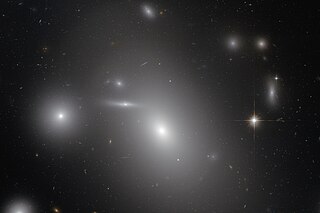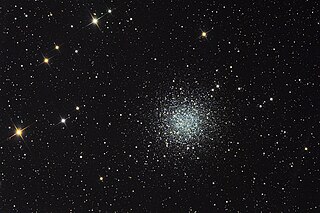
Dorado is a constellation in the Southern Sky. It was named in the late 16th century and is now one of the 88 modern constellations. Its name refers to the dolphinfish, which is known as dorado in Spanish, although it has also been depicted as a swordfish. Dorado contains most of the Large Magellanic Cloud, the remainder being in the constellation Mensa. The South Ecliptic pole also lies within this constellation.

The Jewel Box is an open cluster in the constellation Crux, originally discovered by Nicolas Louis de Lacaille in 1751–1752. This cluster was later named the Jewel Box by John Herschel when he described its telescopic appearance as "...a superb piece of fancy jewellery". It is easily visible to the naked eye as a hazy star some 1.0° southeast of the first-magnitude star Mimosa. This hazy star was given the Bayer star designation "Kappa Crucis", from which the cluster takes one of its common names. The modern designation Kappa Crucis has been assigned to one of the stars in the base of the A-shaped asterism of the cluster

The Collinder catalogue is a catalogue of 471 open clusters compiled by Swedish astronomer Per Collinder. It was published in 1931 as an appendix to Collinder's paper On structural properties of open galactic clusters and their spatial distribution.

NGC 4889 is an E4 supergiant elliptical galaxy. It was discovered in 1785 by the British astronomer Frederick William Herschel I, who catalogued it as a bright, nebulous patch. The brightest galaxy within the northern Coma Cluster, it is located at a median distance of 94 million parsecs from Earth. At the core of the galaxy is a supermassive black hole that heats the intracluster medium through the action of friction from infalling gases and dust. The gamma ray bursts from the galaxy extend out to several million light years of the cluster.

NGC 3607 is a small but fairly bright lenticular galaxy in the equatorial constellation of Leo, about 2.5° south of the prominent star Delta Leonis. The galaxy was discovered March 14, 1784 by William Herschel. Dreyer described it as "very bright, large, round, very much brighter middle, 2nd of 3". It is located at a distance of 73 million light years and is receding with a radial velocity of 930 km/s. The galaxy lies southwest of NGC 3626 at an angular separation of ~50′. It occupies the center of the Leo II Group of galaxies, forming one of its two brightest members – the other being NGC 3608. It is a member of the NGC 3607 Group of galaxies, which is a member of the Leo II Groups, a series of galaxies and galaxy clusters strung out from the right edge of the Virgo Supercluster.

NGC 2467, nicknamed the "Skull and Crossbones Nebula", is a star-forming region whose appearance has occasionally also been likened to that of a colorful mandrill. It includes areas where large clouds of hydrogen gas incubate new stars. This region was one of the areas featured in the book Hubble's Universe: Greatest Discoveries and Latest Images by Terence Dickinson.

NGC 1783 is a globular cluster within the Dorado constellation and part of the Large Magellanic Cloud, a satellite dwarf galaxy of the Milky Way. At an aperture of 50 arcseconds, its apparent V-band magnitude is 10.39, making it one of the brightest globular clusters in the LMC as viewed from Earth. It was discovered in 1835 by John Herschel. The compiler of the New General Catalogue, John Louis Emil Dreyer, described this cluster as "considerably bright, large, round, very gradually pretty much brighter middle, mottled but not resolved."

NGC 1901 is an open cluster in the Dorado Constellation. It has a bright middle and is a little rich, with stars from 7th magnitude downwards. The celestial object was discovered on 30 December 1836 by the British astronomer John Herschel. The cluster is sparsely populated with GAIA data suggesting a membership of around 80 stars. It is considered unlikely it will survive its next pass through the Milky Way’s galactic plane in about 18 million years time.

NGC 2164 is a 10th-magnitude open cluster in the Dorado constellation. The celestial object was discovered on September 27, 1826, by the Scottish astronomer James Dunlop. Its apparent size is 2.5 arcmin. It is located in the Large Magellanic Cloud.

NGC 1763 (also known as N11 B, LH 10 or ESO 85-EN20) is an emission nebula with an embedded star cluster in the Dorado constellation in the Large Magellanic Cloud, It is very bright, very large and very irregular. Its apparent size is about 3.0-5.0 arcmin. It is part of a large region of stars called LMC-N11 (N11) which was discovered with a 23-cm telescope by the astronomer James Dunlop in 1826 and was also observed by John Herschel in 1834. The nebula itself is catalogued under LHA 120-N 11B, LH 10 or ESO 85-EN20. It is also part of an area commonly known as the Bean Nebula.

NGC 1755 is an open star cluster in the Large Magellanic Cloud in the Dorado constellation. It is about 120 light years across and due to its size could be a globular cluster. It has a diameter of 2.6′ and an apparent magnitude of 9.9. It was discovered by James Dunlop in 1826.

NGC 330 is an open cluster in the Small Magellanic Cloud. It is located in the constellation Tucana. It was discovered on 1 August, 1826 by James Dunlop. It was described by Dreyer as "a globular cluster, very bright, small, a little extended, stars from 13th to 15th magnitude." At an aperture of 31.0 arcseconds, the apparent V-band magnitude is 9.60, but at this wavelength, it also has 0.36 magnitudes of interstellar extinction.

NGC 361 is an open cluster in the Small Magellanic Cloud. It is located in the constellation Tucana. It was discovered on September 6, 1826 by James Dunlop. It was described by Dreyer as "very very faint, pretty large, very little extended, very gradually brighter middle." At an aperture of 31.0 arcseconds, its apparent V-band magnitude is 12.24, but at this wavelength, it has 0.40 magnitudes of interstellar extinction.

NGC 5897 is a globular cluster in the constellation Libra. This satellite of the Milky Way, which is quite remote, has a diameter of over 170 light years. With its Shapley–Sawyer Concentration Class of XI, it has very low star density even in its center.

NGC 411 is a globular cluster located approximately 55,000 pc (180,000 ly) from Earth in the constellation Tucana. It was discovered in 1826 by James Dunlop. It was described by Dreyer as "extremely faint, pretty large, round, gradually very little brighter middle." At a distance of about 180,000 light years (55,000 parsecs), it is located within the Small Magellanic Cloud. It has a mass of about 3.0×104 M☉, and a luminosity of about 8.0×104 L☉.

NGC 458 is an open cluster located in the constellation Tucana. It was discovered on September 6, 1826, by James Dunlop. It was also observed by John Herschel and DeLisle Stewart. It was described by Dreyer as "pretty faint, large, round, very gradually brighter middle." It was also noted in the second Index Catalogue that it was "probably a cluster, extremely small, close, no nebulosity seen by D.S. ." At an aperture of 31 arcseconds, its apparent V-band magnitude is 11.73, but at this wavelength, it has 0.12 magnitudes of interstellar extinction.

NGC 3311 is a supergiant elliptical galaxy located about 190 million light-years away in the constellation Hydra. The galaxy was discovered by astronomer John Herschel on March 30, 1835. NGC 3311 is the brightest member of the Hydra Cluster and forms a pair with NGC 3309 which along with NGC 3311, dominate the central region of the Hydra Cluster.

NGC 1712, also known as GC 942, JH 2685, and Dunlop 112 is an open cluster in the constellation of Dorado. It is relatively small, and is located inside the Large Magellanic Cloud. NGC 1712 was originally discovered in 1826 by James Dunlop, although Herschel rediscovered it in 1834. Nine variable stars have been discovered in it so far, with three suspected to be binary systems.

NGC 1332 is an almost edge-on elliptical galaxy located in constellation of Eridanus. Situated about 70 million light years away, it is a member of the Eridanus cluster of galaxies, a cluster of about 200 galaxies. It is also the brightest member of the NGC 1332 Group. It was discovered by William Herschel on 9 December 1784.

NGC 4637 is a lenticular galaxy located in the Virgo constellation, originally discovered by R.J. Mitchell on March 1, 1854. It is a member of the Virgo Cluster, and is located in the sky very close to the brighter and larger galaxy NGC 4638, which historically led to some confusion upon discovery and later observations.




















